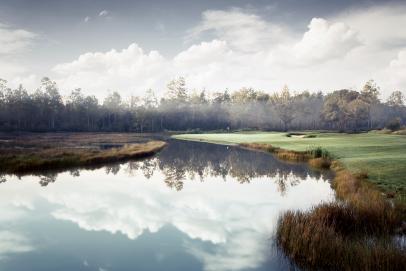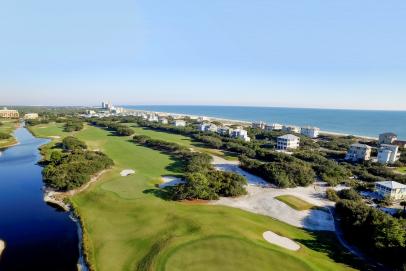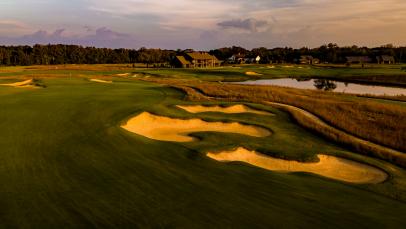
Overview
From Golf Digest Architecture Editor emeritus Ron Whitten:
I've always admired Jerry Pate's work in golf architecture. He was one of the few PGA Tour pros who really got down and dirty in golf design, and I especially liked the few courses he did with architect Bob Cupp. Their second collaboration was Old Waverly in tiny West Point, Miss., a dream project of West Point native George Bryan, who at the time was chairman of the meat division of the Sara Lee Corporation based in the tri-city area (West Point, Starkville and Columbus) known as Mississippi's Golden Triangle.
Cupp was just two years removed from his employment as Jack Nicklaus’ chief designer, and Pate was still active on the PGA Tour when they started the project in August 1986. Both spent a lot of time on the site. I remember Pate was as proud of the massive drainage system he successfully persuaded Old Waverly to adopt as he was of the many strategies he helped impart in its holes.
The course opened in August 1988 to immediate acclaim, finishing No. 3 among Golf Digest's Best New Private Courses in 1989. It was subsequently the site of Juli Inkster’s first U.S. Women’s Open win in 1999 and when Gabriela Ruffels won the 2019 U.S. Women's Amateur there, she became the first Australian to hold the trophy. Old Waverly has ranked among America’s 100 Greatest in 1995 to 1998 and again in 2005 to 2006. More recently, the former private club became semi-private, and now accepts outside play (in a package deal with its second 18 just to the northwest, the Gil Hanse-designed Mossy Oak.) In Golf Digest's latest list of America’s 100 Greatest Public Courses, Old Waverly ranks 75th.
It's always been one of the loveliest courses I've ever played. On a recent visit I found it a bit scruffier than I'd recalled—the once gurgling stream over which you play on the par-3 seventh is now full of tall weeds, for example—but I still think it's the best of the Cupp-Pate collaborations. It weaves from old cattle ranch pasture into dense trees and out again, with five holes on the back nine strung along the shoreline of the 40-acre irrigation pond known as Lake Waverly. I've always liked how the designers posed different fairway routes by using center pot bunkers on certain holes and diagonal streams on others.
But the feature I find most interesting at Old Waverly are the number of crossbunkers that Cupp and Pate used. There's one off the very first tee, not much more than a hundred yards off it, stretching almost clear across the corridor. Another is encountered off the tee on the par-5 second, this time a cluster of four traps—three small, one big—nestled in a depression in front of the tee complex. Another is found on the ninth, this one a long finger poking into the fairway from the left, again some 100 yards off the tee. Another cluster of small bunkers sits just off the tee of the 13th and one last massive crossbunker is recessed at the start of the 16th fairway. The designers called these things their "19th century bunkers," because they brought to their minds the ramparts built in the earliest days of golf in America.
What I find interesting in retrospect is that Cupp and Pate did these things back in 1988, decades before the present generation of golf architects are making statements with the same sort of crossbunkers that they attribute to the Golden Age architects. Guys like Doak and Hanse and Silva and others use them mainly because they like the artistry of the things; on certain holes, a crossbunker right in front of the tee just seems to fit and frame the tee shot.
Of course, A.W. Tillinghast spent a couple of years in the 1930s traveling the country urging clubs to save money by filling in such crossbunkers, calling them, "Duffer Headaches." What's different today, of course, is that most courses now have far more tee boxes per hole, so duffers can move up and easily carry such crossbunkers or avoid them entirely.
And that was true back in 1988 at Old Waverly. Cupp and Pate had four sets of tees on every hole, most of them placed diagonally along the lines of play so the crossbunkers weren't really a factor for high-handicappers from the forward tees.
I'm not yet prepared to declare that Bob Cupp and Jerry Pate reignited the crossbunker craze that still exists in golf architecture these days, but I'm pretty certain I'm correct in saying that no designer has used them on a single course with the frequency that Cupp and Pate did at Old Waverly more than 30 years ago.
About
Awards



100 Greatest: Ranked from 1995-'98, 2005-'06. Highest ranking: No. 88, 1995-'96.
100 Greatest Public: Ranked since 2011. Highest ranking: No. 29, 2011-'12. 2021-'22 ranking: No. 75.
Best in State: Ranked first, 1991-2007. Ranked second, 2011-'18. Ranked third, 2019-'24.
Current ranking: 3rd.
Panelists
Ratings from our panel of 1,900 course-ranking panelists
100 GREATEST/BEST IN STATE SCORES
Shot Options
Character
Challenge
Layout Variety
Fun
Aesthetics
Conditioning
Reviews
Review
“Good property with rolling hills, ponds, creeks in play. Condition good but bit wet. Fun to play."
Read More2018
Review
“In spite of its name Old Waverly is a 1988 Bob Cupp design. this fashionable club has excellent course. It keeps your interest from start to finish."
Read More2018
Review
“Old Waverly is a great southern experience. Very nice layout but to truly get the whole experience, you should stay in the cottages which allows a non-member to have access to play Old Waverly and make sure to eat in the grand old clubhouse. Nice layout on this course which hosted a US Women's Open. The ownership and staff are very service oriented."
Read More2018
Readers
Collection of reviews from our readers










There are no readers reviews yet. Be the first to write a review.